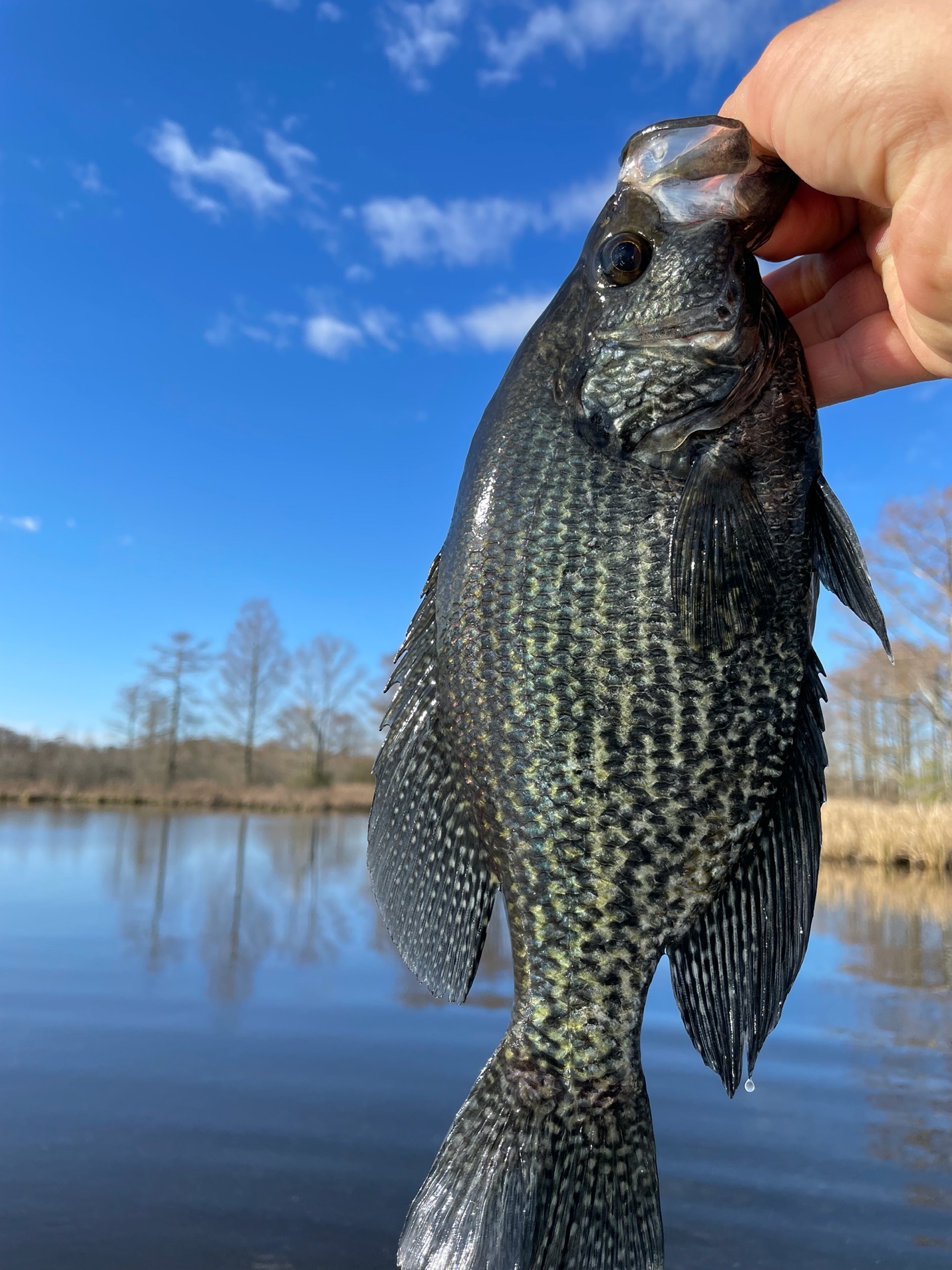With water temperatures higher than normal due to a mild winter and an early full moon this month we checked in with our freckle fishing experts to find out their advice on fishing for spawning crappie. Josh Morris of the Richmond Crappie Club and C.C. McCotter, long-time guide on Lake Anna shared their thoughts on locating crappie spawning areas and then how to catch ‘em.
“Pre-spawn can be the most rewarding time of the year to crappie fish, and when the water temperature reaches 55o F, expect the crappie to begin spawning,” Morris told W2.
He noted the depth at which the crappie spawn is typically dependent on the water clarity of the lake your river you are fishing – the muddier the water, the shallower crappie will spawn. Occasionally, Morris noted you can find crappie spawning in deeper water where they’ll suspend on standing timber. For the most part, though, he says to plan on fishing near the backs of the creeks during the spawn and look for cover like brush piles, stumps, lily pads and standing timber.
Morris shared his temperature-based system by the numbers.
“When water temperature is less than 50 F, I rarely fish brush unless in clear water. Once the water temperature rises above that 50o mark, I’ll start looking for fish in open water as well as on brush. During the pre-spawn, fish will be feeding heavily so look for bait and typically the crappie will be nearby. If a creek channel is well defined, I’ll oftentimes follow the creek channel while fishing as this can sometimes be a highway for the crappie.”
Morris says spider rigging is one of the most effective techniques to use during the pre-spawn. When feeding heavily, crappie won’t be as picky on the type of bait or presentation. He will typically use hair jigs, minnows, or a hair jig tipped with a minnow.
As the water temperature continues to warm and the crappie get more aggressive, trolling jigs behind the boat (long-lining) can be a highly effective technique as well. Typical long-lining speeds are 1-1.5 mph while spider rigging is better suited around 0.3-0.5 mph. Hence, you can cover three times as much water when long-lining. The water temperature and aggressive of the fish will dictate which technique will be more productive.
Casting plastics is another technique that Morris says can be a lot of fun as well once the crappie get on cover. A slip bobber is yet another technique that can a lot of fun for people of all ages.
On Morris’ home water of Chickahominy Lake, Johnson and Lacey Creeks can produce some of the most enjoyable spawning crappie fishing in the state. Eventually, the lily pads will become loaded with crappie and you can dip the pads with a long rod, cork, and a minnow.
He says to just place the bait in between the pads for about 10 seconds and then move to another opening. Generally, if the fish are there you’ll get a bite almost immediately.
The spawn produces some of the biggest crappie of the year. With that said, for most tournament anglers, it can actually be the toughest time of the year to consistently compete because the crappie can be almost anywhere and coming up with seven big fish can be a challenge. I recommend folks to throw the big females back and take home fish in the 10-13” range.
McCotter has fished for crappie all over the state but guides on Anna where he can encounter clear, stained and muddy water in the same lake on the same day. He agrees with Morris that the clearer the water, the deeper the fish will be and McCotter has created many brush piles over the years to attract and concentrate crappie in the mid and up lake sections of Anna.
“Crappie are starved for good habitat in much of Anna so augmentation with sunken brush is helpful to them and to us as anglers. I’ll track fish from our deep, main lake brush right to the creeks they will spawn in starting in early March,” he told W2.
He says the backs of creeks with shad will often draw schools of crappie that action just like bass. You might even be bass fishing and accidently catch one on a swimbait or crankbait. McCotter says the crappie alarm bell should ring if that happens as you are probably around a school feeding on the baitfish. Crappie do this prior to spawning.
On Anna he’ll often target spawning crappie in shoreline willow grass. It’s not easy due to the snaggy stems and the tendency of the crappie to be inside the grass line but it is possible.
“I will follow the fish to the shallows where the best time to catch the biggest crappie is when the females loiter just off the grass lines. The males (they will be very dark) are already on the grass waiting for them. This usually happens when the water hits 55 around a full moon.”
McCotter utilizes slip bobber and minnows for some clients and casted jigs with others depending on the skill level.
“If you can cast precisely and present a 1/16-oz., two-inch, straight tail jig on six-pound test with a six-foot, light action rod, we are going to be best crappie fishing buddies. If you keep firing the jig into the grass, we’re going to have to give you the bobber rod, though,” McCotter says. Snagging the grass immediately turns off the fish.
Once the females get to the males on the beds, the fishing is more difficult, and minnows or jigs must be presented on the beds inside the grass lines or other nesting structure like a beaver hut or downed tree.
Now you know how two top crappie anglers will get after ‘em this spring. Stop by your local tackle shop to get geared up and see if the freckles are biting in your neck of the woods.



